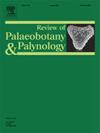Oldest menispermaceous endocarp fossil from the Deccan Intertrappean Beds of Central India and its biogeographic implications
IF 1.7
3区 地球科学
Q2 PALEONTOLOGY
引用次数: 0
Abstract
Palaeosinomenium Chandler, a fossil genus of the Menispermaceae, has a characteristic endocarp morphology that is easily identified in the fossil floras. Palaeosinomenium was widely distributed in the Paleogene, based on reports from North America, Europe, and East Asia, but was not known from South Asia. Here, we recognize a new fossil-species, Palaeosinomenium indicum sp. nov., based on an endocarp mold and locule cast from the latest Maastrichtian (late Cretaceous)-earliest Danian (early Paleocene) sediments (c. 66–65 Ma old) of the Deccan Intertrappean beds of the Umariya site in Madhya Pradesh, Central India. This new species is characterized by a horseshoe-shaped endocarp with a broad-rounded dorsal margin, almost equal limbs, and a nearly straight ventral margin. It has one dorsal ridge, shallowly concave lateral faces, and a pair of c-shaped lateral ridges one on each side of the plane of bisymmetry, and about 19 radially aligned dorsal ribs. This new finding is the earliest fossil fruit evidence of Menispermaceae indicating an early occurrence of the family in Gondwana.
印度中部德干夹层最古老的半生质内果皮化石及其生物地理意义
作为menispermacaceae的一个化石属,Palaeosinomenium Chandler具有典型的内果皮形态,在化石区系中很容易识别。根据北美、欧洲和东亚的报道,古近系古红藓属广泛分布于古近系,但在南亚尚未发现。在此,我们发现了一个新的化石种——Palaeosinomenium indicum sp. nov.,它是基于印度中部中邦Umariya遗址德干圈层最晚期(晚白垩世)-最早期(早古新世)马斯垂克期(约66-65 Ma)沉积物的内模和腔体铸造而成的。这个新种的特征是马蹄形的内果皮,宽而圆的背缘,几乎相等的四肢和几乎直的腹缘。它有一个背脊,浅凹的侧面,在双对称面两侧各有一对c形的侧脊,约有19条径向排列的背肋。这一新发现是menispermacae科最早的水果化石证据,表明该科早在冈瓦纳出现。
本文章由计算机程序翻译,如有差异,请以英文原文为准。
求助全文
约1分钟内获得全文
求助全文
来源期刊
CiteScore
3.50
自引率
21.10%
发文量
149
审稿时长
6 months
期刊介绍:
The Review of Palaeobotany and Palynology is an international journal for articles in all fields of palaeobotany and palynology dealing with all groups, ranging from marine palynomorphs to higher land plants. Original contributions and comprehensive review papers should appeal to an international audience. Typical topics include but are not restricted to systematics, evolution, palaeobiology, palaeoecology, biostratigraphy, biochronology, palaeoclimatology, paleogeography, taphonomy, palaeoenvironmental reconstructions, vegetation history, and practical applications of palaeobotany and palynology, e.g. in coal and petroleum geology and archaeology. The journal especially encourages the publication of articles in which palaeobotany and palynology are applied for solving fundamental geological and biological problems as well as innovative and interdisciplinary approaches.

 求助内容:
求助内容: 应助结果提醒方式:
应助结果提醒方式:


